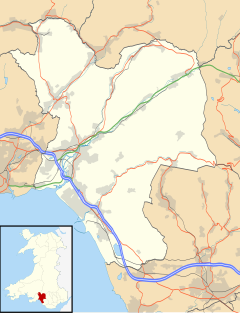Baglan Industrial Park
Aberavon
|
|
|---|---|
 Aberavon from Mynydd Dinas |
|
| Aberavon shown within Neath Port Talbot | |
| Population | 5,452 (2011 census) |
| OS grid reference | SS752904 |
| Principal area | |
| Ceremonial county | |
| Country | Wales |
| Sovereign state | United Kingdom |
| Post town | PORT TALBOT |
| Postcode district | SA12 |
| Dialling code | 01639 |
| Police | South Wales |
| Fire | Mid and West Wales |
| Ambulance | Welsh |
| EU Parliament | Wales |
| UK Parliament | |
| Welsh Assembly | |
| Councillors |
|
Aberavon (Welsh: Aberafan) is a settlement in Neath Port Talbot county borough, Wales. The town derived its name from being near the mouth of the river Afan, which also gave its name to a medieval lordship. Today it is essentially a district of Port Talbot, covering the central and south western part of the town. Aberavon is also the name of the nearby Blue Flag beach and the parish covering the same area.
Little is known about Aberavon before Norman times. Bronze Age remains have been found in the hills behind the town. Roman artifacts have been found near the sea, including when the docks were being built in the 19th century.
About 1090 the invading Normans deposed Iestyn ap Gwrgant, the ruler of Glamorgan. His son, Caradog ab Iestyn, was the only Welsh lord to retain lands in Glamorgan - the area between the Afan and Neath rivers - and he became the first of the Lords of Afan. Caradoc built a castle in Aberafan near the present site of St Mary's Church. This wooden castle was burnt down in 1153 and Caradoc's son, Morgan ap Caradoc, rebuilt the castle in stone. In 1147 Cistercian monks founded the nearby Margam Abbey. In 1241 the Lordship passed to Morgan Fychan. His son Leisan D'Avene was the first known by a Norman-style surname. In 1304 Leisian D'Avene adopted the town's first charter. By 1373 the town passed into the hands of Edward le Despencer, Lord of Glamorgan, and the Lords of Afan had ceased to be.
The English antiquarian John Leland made an extensive journey through Wales c.1536-39 of which he recorded an itinerary. He passed through Aberafan, which he describes as a "poor village" surrounded by barren ground, though he also describes the area as heavily wooded, not much of which remains today. He mentions the use of the river mouth as a port, a "haven for ships" as he puts it. His portrayal of Aberafan as a small, struggling village however suggests that the port was not in great use, especially as traffic to and from Margam Abbey would have ceased following its dissolution in 1536.
...
Wikipedia

